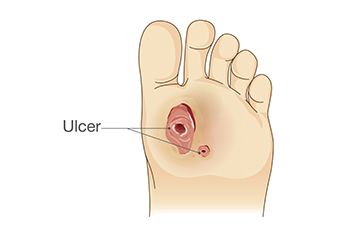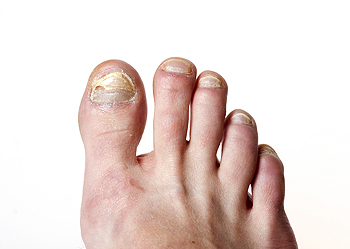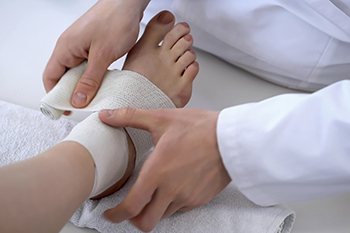Items filtered by date: July 2023
The Seriousness of a Diabetic Foot Ulcer

People who are diabetic are generally concerned about developing a diabetic foot ulcer. Proper wound care treatment is crucial for this type of infection, and serious consequences may ensue if prompt medical attention is not received. Research has shown that approximately 25 percent of diabetic patients will develop a foot ulcer, and implementing prevention techniques may help to avoid this. An essential step for this type of wound care treatment can be to remove the necrotic or dead wound tissue. This is referred to as debridement, and there are various ways to treat this. It is important to reduce any pressure on the wound, and often an off-loading boot is worn. The wound is typically drained, and the healthy underlying tissue is examined. Effective prevention methods can include keeping glucose levels within a normal range, drinking plenty of water daily, and eating healthy foods. If you have a diabetic foot ulcer, it is strongly suggested that you are under the care of a podiatrist who can provide the proper treatment.
Wound care is an important part in dealing with diabetes. If you have diabetes and a foot wound or would like more information about wound care for diabetics, consult with Ramin Nadjafi, DPM from Advanced Podiatry Group. Our doctor will assess your condition and provide you with quality foot and ankle treatment.
What Is Wound Care?
Wound care is the practice of taking proper care of a wound. This can range from the smallest to the largest of wounds. While everyone can benefit from proper wound care, it is much more important for diabetics. Diabetics often suffer from poor blood circulation which causes wounds to heal much slower than they would in a non-diabetic.
What Is the Importance of Wound Care?
While it may not seem apparent with small ulcers on the foot, for diabetics, any size ulcer can become infected. Diabetics often also suffer from neuropathy, or nerve loss. This means they might not even feel when they have an ulcer on their foot. If the wound becomes severely infected, amputation may be necessary. Therefore, it is of the upmost importance to properly care for any and all foot wounds.
How to Care for Wounds
The best way to care for foot wounds is to prevent them. For diabetics, this means daily inspections of the feet for any signs of abnormalities or ulcers. It is also recommended to see a podiatrist several times a year for a foot inspection. If you do have an ulcer, run the wound under water to clear dirt from the wound; then apply antibiotic ointment to the wound and cover with a bandage. Bandages should be changed daily and keeping pressure off the wound is smart. It is advised to see a podiatrist, who can keep an eye on it.
If you have any questions, please feel free to contact our office located in Orlando, FL . We offer the newest diagnostic and treatment technologies for all your foot care needs.
Understanding Polydactyly

Polydactyly is a congenital foot defect where a child is born with extra fingers or toes. The name comes from a combination of Greek words, “poly” for many and “dactylos” for digits. There are different types of polydactyly of the feet. The most frequent form is an extra toe next to the fifth toe. The extra digit can be complete and fully functional or partially formed with some bone. It can also present as a small mass of soft tissue. When polydactyly occurs without other abnormalities, it is referred to as isolated or non-syndromic polydactyly. When there is another genetic condition present, such as a cognitive and developmental abnormality, it is called syndromic polydactyly. This condition tends to be hereditary and can occur from genetic mutations and environmental reasons. The left foot is most often affected and is twice as common among males. Treatment for polydactyly is dependent on where the extra toe is. Surgery to remove the extra toe is frequently done in the first two years of a child’s life to allow typical use of the foot and a better ability to fit into shoes. If you have a baby born with polydactyly, it is strongly suggested that you take them to a podiatrist as soon as possible who can consult with you on the best way to treat this condition.
Congenital foot problems require immediate attention to avoid future complications. If you have any concerns, contact Ramin Nadjafi, DPM of Advanced Podiatry Group. Our doctor can provide the care you need to keep you pain-free and on your feet.
Congenital foot problems are deformities affecting the feet, toes, and/or ankles that children are born with. Some of these conditions have a genetic cause while others just happen. Some specific foot ailments that children may be born with include clubfeet, polydactyly/macrodactyly, and cleft foot. There are several other foot anomalies that can occur congenitally. What all of these conditions have in common is that a child may experience difficulty walking or performing everyday activities, as well as trouble finding footwear that fits their foot deformity. Some of these conditions are more serious than others. Consulting with a podiatrist as early as possible will help in properly diagnosing a child’s foot condition while getting the necessary treatment underway.
What are Causes of Congenital Foot Problem?
A congenital foot problem is one that happens to a child at birth. These conditions can be caused by a genetic predisposition, developmental or positional abnormalities during gestation, or with no known cause.
What are Symptoms of Congenital Foot Problems?
Symptoms vary by the congenital condition. Symptoms may consist of the following:
- Clubfoot, where tendons are shortened, bones are shaped differently, and the Achilles tendon is tight, causing the foot to point in and down. It is also possible for the soles of the feet to face each other.
- Polydactyly, which usually consists of a nubbin or small lump of tissue without a bone, a toe that is partially formed but has no joints, or an extra toe.
- Vertical talus, where the talus bone forms in the wrong position causing other bones in the foot to line up improperly, the front of the foot to point up, and the bottom of the foot to stiffen, with no arch, and to curve out.
- Tarsal coalition, when there is an abnormal connection of two or more bones in the foot leading to severe, rigid flatfoot.
- Cleft foot, where there are missing toes, a V-shaped cleft, and other anatomical differences.
- Macrodactyly, when the toes are abnormally large due to overgrowth of the underlying bone or soft tissue.
Treatment and Prevention
While there is nothing one can do to prevent congenital foot problems, raising awareness and receiving neonatal screenings are important. Early detection by taking your child to a podiatrist leads to the best outcome possible.
If you have any questions please feel free to contact our office located in Orlando, FL . We offer the newest diagnostic tools and technology to treat your foot and ankle needs.
Ignoring Toenail Fungus Can Be Harmful

A sign that you may have developed toenail fungus is the yellow appearance of the nails. They may also become thicker and begin to crumble. If ignored, a fungal toenail infection, medically termed onychomycosis, may result in other problems. It can easily spread to other parts of the foot simply by not changing socks and shoes daily. Toenail fungus is especially risky for diabetics, whose skin may have cracked as a result of poor circulation. This allows for the additional possibility of bacteria entering the body, and may in turn cause cellulitis. In some cases of fungal toenail infections, the only way to treat it is to remove the nail. The nail will grow back with time. If the infection is extremely serious, the toenail may have to be permanently removed, by performing a procedure called matrixectomy. This destroys the growing center at the base of the nail bed, ensuring that the fungus will not grow back. If you have toenail fungus, it is suggested that you make an appointment with a podiatrist for an examination and treatment options.
If left untreated, toenail fungus may spread to other toenails, skin, or even fingernails. If you suspect you have toenail fungus it is important to seek treatment right away. For more information about treatment, contact Ramin Nadjafi, DPM of Advanced Podiatry Group. Our doctor can provide the care you need to keep you pain-free and on your feet.
Symptoms
- Warped or oddly shaped nails
- Yellowish nails
- Loose/separated nail
- Buildup of bits and pieces of nail fragments under the nail
- Brittle, broken, thickened nail
Treatment
If self-care strategies and over-the-counter medications does not help your fungus, your podiatrist may give you a prescription drug instead. Even if you find relief from your toenail fungus symptoms, you may experience a repeat infection in the future.
Prevention
In order to prevent getting toenail fungus in the future, you should always make sure to wash your feet with soap and water. After washing, it is important to dry your feet thoroughly especially in between the toes. When trimming your toenails, be sure to trim straight across instead of in a rounded shape. It is crucial not to cover up discolored nails with nail polish because that will prevent your nail from being able to “breathe”.
In some cases, surgical procedure may be needed to remove the toenail fungus. Consult with your podiatrist about the best treatment options for your case of toenail fungus.
If you have any questions, please feel free to contact our office located in Orlando, FL . We offer the newest diagnostic and treatment technologies for all your foot care needs.
Causes and Treatments of Ankle Sprains

There are some people who roll their ankle, and refer to it as an ankle sprain. It is considered to be one of the most common injuries among people who participate in sporting activities, and affects the ligaments in the ankle. It can also happen from unexpectedly stepping off of a curb, where the ankle can suddenly twist. A diagnosis is often performed, which consists of having an X-ray taken. This is generally successful in confirming the sprain and ruling out a fractured foot. Treatment can begin with resting the affected foot as often as possible, and elevating it may help to reduce existing swelling. It is beneficial to keep weight off of the foot, and wearing a protective boot or using crutches may help with mobility. Relief may be found when the ankle is wrapped in an elastic bandage, which can provide the necessary support as the healing process occurs. If you have sprained your ankle, it is suggested that you confer with a podiatrist who can accurately diagnose it, and offer relief and treatment solutions.
Although ankle sprains are common, they aren’t always minor injuries. If you need your ankle injury looked at, contact Ramin Nadjafi, DPM from Advanced Podiatry Group. Our doctor can provide the care you need to keep you pain-free and on your feet.
How Does an Ankle Sprain Occur?
Ankle sprains are the result of a tear in the ligaments within the ankle. These injuries may happen when you make a rapid shifting movement while your foot is planted. A less common way to sprain your ankle is when your ankle rolls inward while your foot turns outward.
What Are the Symptoms?
- Pain at the sight of the tear
- Bruising/Swelling
- Ankle area is tender to touch
- In severe cases, may hear/feel something tear
- Skin discoloration
Preventing a Sprain
- Wearing appropriate shoes for the occasion
- Stretching before exercises and sports
- Knowing your limits
Treatment of a Sprain
In many cases, the RICE method (Rest, Ice, Compression, and Elevate) is used to treat ankle sprains. However, you should see a podiatrist to see which treatment option would work best with your injury. In severe cases, surgery may be required.
It is important to ask your doctor about rehab options after you receive treatment for your injury. Stretching, strength training, and balance exercises may help the ankle heal while also preventing further injury.
If you have any questions, please feel free to contact our office located in Orlando, FL . We offer the newest diagnostic and treatment technologies for all your foot care needs.
